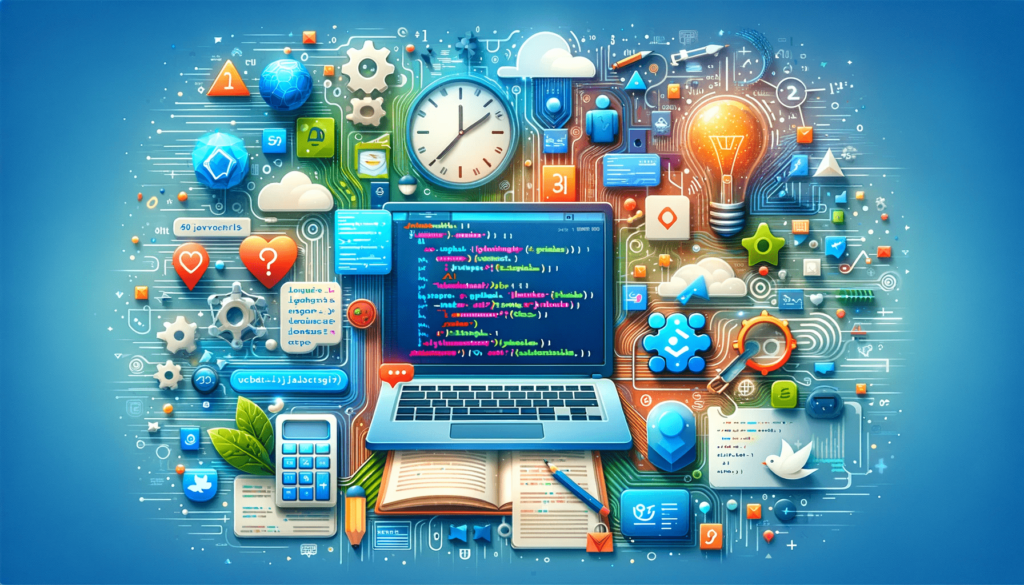Programming is a highly sought-after skill in today’s job market, and learning it can seem like a daunting task for beginners. However, there are step-by-step guides and resources available to help make the learning process fun and accessible. Programming involves communicating with computers using programming languages, which act as translators between human language and computer binary. Different programming languages serve different purposes, and some popular ones include Java, Python, Ruby, and JavaScript. Programming can be divided into front-end and back-end development, with front-end focusing on user experience and design, and back-end focusing on the functionality and performance of a program or website. There are also different programming paradigms, with the two main ones being imperative and declarative. Imperative programming involves giving the computer step-by-step commands, while declarative programming focuses on specifying the desired outcome without providing the instructions. Additionally, programming languages can be either compiled or interpreted, with compiled languages being directly translated by the computer and interpreted languages requiring a separate program to read and execute the code. Syntax is the set of rules that defines the structure of a programming language, while semantics refers to the logical meaning of the language elements. Programming involves using variables, which store data, and working with different data types, such as integers, floats, booleans, and strings. Conditionals allow for different blocks of code to be executed based on certain conditions, and loops allow for repeating a block of code for different values. Overall, learning to code is a valuable and rewarding skill that can lead to various career opportunities.
Key Takeaways:
- Programming is a sought-after skill in today’s job market.
- Learning programming can be challenging for beginners, but there are resources available to help.
- Programming languages act as translators between human language and computer binary.
- Popular programming languages include Java, Python, Ruby, and JavaScript.
- Front-end development focuses on user experience and design, while back-end development focuses on functionality and performance.
Understanding Programming Languages
Programming involves communicating with computers using programming languages, which act as translators between human language and computer binary. Learning a programming language is the first step towards becoming a coder. Let’s explore some popular coding languages for beginners and discover the best coding resources to support your learning journey.
Popular Coding Languages for Beginners
In the vast world of programming languages, several options are suitable for beginners. Java, Python, Ruby, and JavaScript are widely recognized as beginner-friendly languages. Each language has its strengths and purposes:
| Language | Strengths |
|---|---|
| Java | Used for desktop and Android app development, known for its robustness and security. |
| Python | Known for its simplicity and readability, used for web development, data analysis, and artificial intelligence. |
| Ruby | Recognized for its elegant syntax and ease of use, widely used for web development with the Ruby on Rails framework. |
| JavaScript | The language of the web, used for front-end and back-end development, known for its versatility and wide range of frameworks and libraries. |
To start your coding journey, it’s essential to choose a language that aligns with your goals and interests. Consider exploring tutorials, online courses, and coding communities specializing in your chosen language to enhance your learning experience.
Best Coding Resources for Beginners
When embarking on your coding journey, having access to the right resources is crucial. Fortunately, there are numerous online platforms and tools that provide comprehensive learning materials for beginners. Here are some highly recommended coding resources:
- Codecademy: A popular online platform offering interactive coding courses for beginners, covering various programming languages.
- FreeCodeCamp: A non-profit organization providing a free and interactive coding curriculum, along with real-world projects to build your skills.
- MDN Web Docs: Mozilla’s extensive documentation for web development, offering detailed explanations and practical examples.
- Stack Overflow: An online community where programmers can ask questions, seek advice, and share knowledge with fellow coders.
These resources are just a starting point, and there are many more options available. Exploring different platforms and finding what works best for you can greatly accelerate your coding journey.
Front-End and Back-End Development
Programming can be divided into front-end and back-end development, with front-end focusing on user experience and design, and back-end focusing on the functionality and performance of a program or website. Front-end development involves creating the visual and interactive elements of a website or application that users interact with directly. This includes designing the layout, choosing colors and fonts, and implementing user-friendly features such as forms and buttons. Front-end developers use HTML, CSS, and JavaScript to bring their designs to life and ensure a smooth and engaging user experience.
On the other hand, back-end development focuses on the behind-the-scenes processes that make a website or application function effectively. This includes managing databases, handling user authentication and security, and ensuring the overall performance and efficiency of the program. Back-end developers often work with programming languages such as PHP, Python, and Ruby, as well as frameworks like Laravel and Django, to build the logic and functionality that powers the front-end interface.
By combining front-end and back-end development, programmers can create fully functional and visually appealing websites and applications. These two aspects of programming work together to provide a seamless user experience while ensuring the efficient processing of data and the smooth operation of the program. Whether one’s interest lies in design or problem-solving, understanding both front-end and back-end development is essential for becoming a well-rounded programmer.
Front-End and Back-End Development Comparison
| Front-End Development | Back-End Development |
|---|---|
| Focuses on user experience and design | Focuses on functionality and performance |
| Involves creating the visual and interactive elements of a website or application | Involves managing databases and handling server-side processes |
| Uses HTML, CSS, and JavaScript | Uses programming languages like PHP, Python, and Ruby |
| Front-end frameworks include Bootstrap and React | Back-end frameworks include Laravel and Django |
Understanding the distinction between front-end and back-end development is crucial for beginners starting their coding journey. It allows them to focus their learning efforts on the area that aligns with their interests and career goals. Whether one chooses to specialize in front-end or back-end development, both play integral roles in creating successful and user-friendly websites and applications.
Programming Paradigms
There are also different programming paradigms, with the two main ones being imperative and declarative. Imperative programming involves giving the computer step-by-step commands, instructing it on how to solve a problem. It focuses on the sequence of actions and the manipulation of variables to achieve the desired outcome. This approach is commonly used in languages like C, C++, and Java, where the code is written as a series of instructions to be executed by the computer.
On the other hand, declarative programming focuses on specifying the desired outcome without providing explicit instructions on how to achieve it. Instead of defining the sequence of steps, declarative programming emphasizes the logic and relationships between various elements of the program. Languages like SQL, HTML, and Prolog utilize a declarative approach, making it easier for programmers to express complex concepts and let the computer handle the execution details.
Functional Programming
Another popular programming paradigm is functional programming, which treats computation as the evaluation of mathematical functions. In functional programming, programs are composed of pure functions that don’t have side effects and always produce the same output for a given input. This paradigm focuses on immutability and the avoidance of shared state, leading to code that is easier to reason about, test, and maintain.
Functional programming languages like Haskell, Scala, and Clojure are gaining popularity for their ability to handle complex computations and provide elegant solutions. By using higher-order functions, recursion, and immutability, developers can write concise and efficient code that is less prone to bugs and easier to parallelize.
| Programming Paradigm | Main Features | Example Languages |
|---|---|---|
| Imperative | Step-by-step commands, manipulation of variables | C, C++, Java |
| Declarative | Specification of desired outcome, focus on logic and relationships | SQL, HTML, Prolog |
| Functional | Computation as the evaluation of mathematical functions, immutability | Haskell, Scala, Clojure |
Understanding different programming paradigms can expand your toolkit as a programmer, enabling you to choose the most appropriate approach for solving specific problems. Whether you prefer the explicit control of imperative programming, the declarative nature of defining outcomes, or the elegance of functional programming, each paradigm offers unique benefits and challenges. With practice and experience, you can become proficient in multiple paradigms, enhancing your ability to tackle complex programming tasks and write efficient, maintainable code.
Compiled and Interpreted Languages
Programming languages can be either compiled or interpreted, with compiled languages being directly translated by the computer and interpreted languages requiring a separate program to read and execute the code. Let’s take a closer look at these two types of languages and how they function.
Compiled Languages
In compiled languages, the source code is first passed through a compiler, which translates the code into machine language that the computer can directly understand and execute. This compilation process typically results in creating an executable file that can be run independently.
One advantage of compiled languages is their efficiency and speed, as the code is already translated into machine language before execution. Popular compiled languages include C, C++, and Rust.
Interpreted Languages
In contrast, interpreted languages do not require compilation. Instead, the source code is processed line by line at runtime by a separate program called an interpreter. The interpreter reads and executes the code directly, translating it on the fly.
Interpreted languages are often more flexible and easier to learn, as they allow for more dynamic code execution and provide immediate feedback during development. Popular interpreted languages include Python, Ruby, and JavaScript.
Comparison
Here’s a summary of the main differences between compiled and interpreted languages:
| Compiled Languages | Interpreted Languages |
|---|---|
| Source code is translated into machine language before execution. | Source code is read and executed line by line at runtime. |
| Produces an executable file that can be run independently. | Does not produce an executable file; relies on an interpreter to execute the code. |
| Typically faster and more efficient. | Allows for more flexibility and immediate feedback. |
Understanding the distinction between compiled and interpreted languages is crucial for beginner programmers. Depending on the project requirements and personal preferences, you can choose the most appropriate programming language and approach to achieve your goals. Whether you opt for a compiled language like C or an interpreted language like Python, the key is to practice and experiment with different languages to deepen your understanding of coding step by step.
Syntax, Semantics, Variables, Conditionals, and Loops
Programming involves using variables, which store data, and working with different data types, such as integers, floats, booleans, and strings. Variables act as containers that hold information and can be assigned different values throughout the program. They play a crucial role in manipulating and manipulating data in programming languages.
When working with variables, it is important to understand their syntax and semantics. Syntax refers to the set of rules that defines the structure of a programming language. Each programming language has its own syntax, which must be followed to write valid code. Syntax errors occur when the code violates these rules. Semantics, on the other hand, refers to the logical meaning of the language elements. It determines how code constructs are interpreted and executed. Understanding the semantics of a programming language helps ensure that the code behaves as expected.
Conditionals and loops are essential concepts in programming that allow for more dynamic and flexible code execution. Conditionals allow you to create different paths in your code based on specific conditions. For example, you can have code that executes if a certain variable is greater than a specified value. This allows you to control the flow of your program and make decisions based on different situations.
Loops, on the other hand, allow you to repeat a block of code multiple times. They are especially useful when you need to perform the same task multiple times with different data values. There are different types of loops, such as for loops, while loops, and do-while loops, each with its own syntax and use cases. By using loops, you can automate repetitive tasks and make your code more efficient and concise.
Summary
- Programming involves using variables to store and manipulate data.
- Syntax defines the structure of a programming language, while semantics determines the logical meaning of language elements.
- Conditionals allow for different paths in your code based on specific conditions.
- Loops allow for the repetition of code blocks multiple times.
Complete Table Example:
| Variable | Data Type | Example |
|---|---|---|
| age | Integer | 25 |
| temperature | Float | 23.5 |
| isSunny | Boolean | true |
| name | String | “John Doe” |
Conclusion
Learning to code is a valuable and rewarding skill that can lead to various career opportunities. In today’s job market, programming is highly sought after, and acquiring this skill may seem daunting for beginners. However, there are step-by-step guides and resources available to make the learning process fun and accessible.
Programming involves using programming languages as translators between human language and computer binary. Different programming languages serve different purposes, and some popular ones include Java, Python, Ruby, and JavaScript. These languages allow individuals to communicate with computers and create software, websites, and applications.
Furthermore, programming can be divided into front-end and back-end development. Front-end development focuses on creating a user-friendly and visually appealing experience, while back-end development emphasizes the functionality and performance of a program or website.
Understanding different programming paradigms is also essential. Imperative programming involves giving step-by-step commands to the computer, while declarative programming focuses on specifying desired outcomes without providing instructions. This understanding shapes the coding process and allows beginners to approach programming problems from different perspectives.
Additionally, it is important to be aware of the distinction between compiled and interpreted languages. Compiled languages are directly translated by the computer, while interpreted languages require a separate program to read and execute the code. This knowledge impacts the execution process and has implications when coding.
Learning programming requires grasping essential elements such as syntax, semantics, variables, conditionals, and loops. Syntax refers to the set of rules that define the structure of a programming language, while semantics determines the logical meaning of language elements. Variables store data in different data types, including integers, floats, booleans, and strings. Conditionals allow for executing different blocks of code based on certain conditions, and loops enable repeating code for different values.
By following this easy guide to coding for beginners, individuals can navigate the complexities of programming step-by-step and access personalized learning resources. Consider checking out our app at Dropout Developer for an enhanced coding experience.
Start your coding journey today and unlock the doors to a world of possibilities!
FAQ
What is programming?
Programming involves communicating with computers using programming languages, which act as translators between human language and computer binary.
What are some popular programming languages?
Some popular programming languages include Java, Python, Ruby, and JavaScript.
What is the difference between front-end and back-end development?
Front-end development focuses on user experience and design, while back-end development focuses on the functionality and performance of a program or website.
What are imperative and declarative programming paradigms?
Imperative programming involves giving the computer step-by-step commands, while declarative programming focuses on specifying the desired outcome without providing the instructions.
What is the difference between compiled and interpreted languages?
Compiled languages are directly translated by the computer, while interpreted languages require a separate program to read and execute the code.
What are syntax and semantics in programming?
Syntax refers to the set of rules that defines the structure of a programming language, while semantics refers to the logical meaning of the language elements.
What are variables, conditionals, and loops in programming?
Variables are used to store data, conditionals allow for different blocks of code to be executed based on certain conditions, and loops allow for repeating a block of code for different values.







